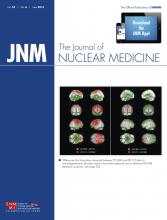REPLY: We welcome the opportunity to respond to McBride and colleagues’ comments on our article (1) in this journal and would like to reflect on the raised points from our perspective.
First, one would not be wrong to assume that the Al18F-chelator protocol has now been recognized by the radiopharmacy community as an innovative and powerful protocol to stably radiolabel biomacromolecules using a simple and direct approach.
Although we certainly have to accept the reported data as they stand, their interpretation seems to have regrettably caused some disagreement with readers. If McBride et al. state that the “renal uptake of the Al18F-Affibody product is a property of the Affibody targeting agent and not the Al18F complex,” we would like to stress that the biodistribution profile as such is of course always a combination of properties of the peptide plus labeling group.
In this context, we also would like to point out that the principal aim of our study was to compare the different bioconjugation protocols and the corresponding pharmacokinetics for a single Affibody motif only. Evidently, our data have revealed differences in the biodistribution and excretion of the 18F-labeled Affibody molecule that can be attributed to the radiolabeling moiety. Our biodistribution results demonstrated that the 18F-AlF–labeled HER2-Affibody molecule was not cleared from the kidneys after 3 h.
Further, whereas we fully accept the conclusion by McBride et al. that “high hepatobiliary accretion might be considered at least as undesirable as the high renal retention,” we also think this always will depend on the intended application. The decisive criterion for the suitability of the tracer will be uptake in the actual organ and secondary tumors to be targeted. In addition, species-related differences in the metabolism also cannot be ruled out. In any case, the ultimate information on tracer suitability should be provided by a dosimetry study.
As for differences in radiolabeling yield compared with Heskamp et al. (2), this is to be explained by the method of measuring. Although we reported in Table 1 the isolated non–decay-corrected radiochemical yield, the referenced study used instant thin-layer chromatography and high-performance liquid chromatography. In our study, analytic high-performance liquid chromatography of a reaction mixture containing 18F-ZHER2:2891-Cys-NOTA-(COOH)2-AlF indeed showed labeling efficiencies of up to 49% (see also Supplemental Fig. 5). Thus, significant loss of product occurred during the purification step using a gel filtration cartridge. Unfortunately, authors do not always explicitly mention the method of measuring radiochemical yields, and this can easily lead to confusion in the interpretation of such data.
Finally, we think the suggested use of an organic co-solvent such as acetonitrile is an intriguing aspect. We agree that our protocol has room for improvements both in the labeling step and in the purification efficiency as mentioned above. Clearly, this matter will have to be addressed in future work. However, the published protocol achieved its purpose of delivering tracer for a biodistribution study.
Footnotes
Published online Apr. 24, 2014.
- © 2014 by the Society of Nuclear Medicine and Molecular Imaging, Inc.







